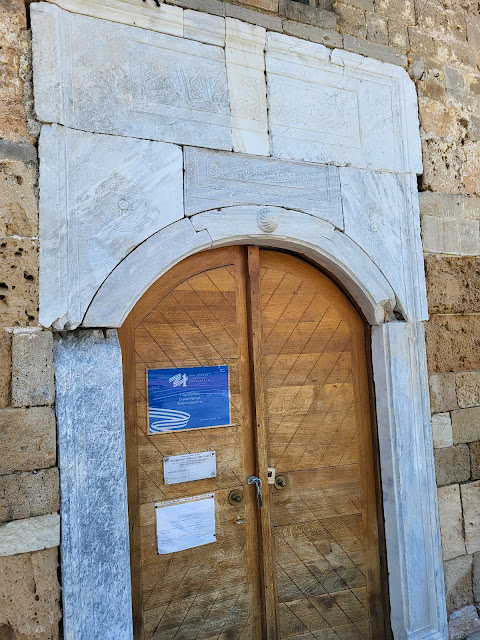Meczet Emira Zade’a (dosł. „Meczet syna emira”) to historyczny meczet z czasów osmańskich w mieście Chalkida na wyspie Eubea w Grecji. Został zbudowany przez Turków wkrótce po upadku Eubei w XV wieku i był jednym z trzech meczetów w obrębie otoczonego murami miasta. Po greckiej wojnie o niepodległość w 1821 r. i wyzwoleniu Chalkidy od Turków osmańskich, został przekształcony w koszary. W 1937 roku został uznany za zabytek historyczny, a dziś mieści część średniowiecznych zbiorów archeologicznych z Chalkis.
Meczet Emira Zade'a posiada prosty styl architektoniczny meczetu z jedną kopułą, podobnie jak większość w Grecji i pozostałych krajach Bałkanów. Oprócz utraconego portyku i minaretu meczet przetrwał w prawie nienaruszonym stanie. Składa się z prostokątnego pomieszczenia nakrytego kopułą, która jest półkulista wewnątrz i ośmiokątna na zewnątrz, wsparta na czterech półstożkowych kopułach. Na marmurowych płytach framugi wejściowej widnieją napisy w języku arabskim, które brzmią: „Wejdź tu w pokoju i będziesz nieśmiertelny w imię wszechmiłosiernego Boga”.
Wewnątrz w ścianie wschodniej umieszczono niszę mihrabu, gdzie do dziś zachowały się ślady koloru i pierwotnego wystroju. Łuk wieńczą dwie kolejne marmurowe tablice z wyrytymi fragmentami Koranu w języku arabskim.
Meczet Emira Zade'a jest szczególnie interesujący ze względu na jego związek z architekturą bizantyjską, na którą wyraźnie wpływał, a także jego integrację ze średniowiecznymi osadami greckimi.
Zachowała się także fontanna na dziedzińcu, nosząca inskrypcje i ozdobiona misternie wytłoczonymi dziełami sztuki arabskiej, zbudowana w 1655 roku.
Wokół meczetu rozmieszczonych jest kilka fragmentów starożytnych kolumn i kapiteli.
The Emir Zade Mosque (lit. 'Mosque of the Emir’s son') is a historical Ottoman-era mosque in the town of Chalcis, on the island of Euboea, Greece. The mosque was built shortly after the fall of Euboea to the Ottomans in the 15th century, and it was one of the three mosques within the walled city. Following the Greek War of Independence in 1821 and the liberation of Chalcis from the Ottoman Turks, it was converted into a barracks. In 1937 it was declared a historical monument, and today it houses part of the medieval archaeological collection of Chalcis. The Emir Zade Mosque is of a simple architectural style of single-dome mosque, like most in Greece and the rest of the Balkans. Aside from the lost portico and minaret, the mosque survives almost intact. It consists of a rectangular room covered by a dome which is hemispherical inside and octagonal outside, resting on four semi-conical domes. The marble slabs of the entrance frame have inscriptions in Arabic, which read “enter here in peace and will be immortal in the name of all-merciful God.” Inside, the niche of the mihrab was placed in the east wall, where traces of colour and the original décor still remain. Two more marble plaques inscribed with excerpts from the Quran in Arabic crown the arch. Preserved is also the fountain in the yard, bearing inscriptions and decorated with elaborately embossed Arabic art, built in 1655. Scattered around the mosque are several fragments of ancient columns and capitals. The Emir Zade mosque is of particular interest due to its relationship with Byzantine architecture, by which it was clearly influenced, as well as its integration into the medieval Greek settlements.
Die Emir-Zade-Moschee (wörtlich „Moschee des Sohnes des Emirs“) ist eine historische Moschee aus der osmanischen Zeit in der Stadt Chalkida auf der griechischen Insel Euböa. Die Moschee wurde kurz nach dem Fall Euböas an die Osmanen im 15. Jahrhundert erbaut und war eine der drei Moscheen innerhalb der ummauerten Stadt. Nach dem griechischen Unabhängigkeitskrieg 1821 und der Befreiung Chalkidas von den osmanischen Türken wurde sie in eine Kaserne umgewandelt. 1937 wurde sie zum historischen Denkmal erklärt und beherbergt heute einen Teil der mittelalterlichen archäologischen Sammlung von Chalkida.
Die Emir-Zade-Moschee ist eine Moschee mit einer einfachen Kuppel, wie die meisten in Griechenland und dem Rest des Balkans. Abgesehen vom verlorenen Portikus und Minarett ist die Moschee fast unversehrt erhalten. Sie besteht aus einem rechteckigen Raum, der von einer Kuppel bedeckt ist, die innen halbkugelförmig und außen achteckig ist und auf vier halbkegelförmigen Kuppeln ruht. Die Marmorplatten des Eingangsrahmens tragen arabische Inschriften, die lauten: „Treten Sie in Frieden ein und werden Sie im Namen des allbarmherzigen Gottes unsterblich sein.“ Im Inneren wurde die Nische des Mihrab in die Ostwand eingebaut, wo noch Farbspuren und das ursprüngliche Dekor erhalten sind. Zwei weitere Marmortafeln mit Auszügen aus dem Koran in arabischer Sprache krönen den Bogen. Erhalten ist auch der Brunnen im Hof, der Inschriften trägt und mit aufwendig geprägter arabischer Kunst verziert ist und 1655 erbaut wurde. Überall in der Moschee sind mehrere Fragmente antiker Säulen und Kapitelle verstreut. Die Emir-Zade-Moschee ist aufgrund ihrer Verbindung zur byzantinischen Architektur, von der sie eindeutig beeinflusst wurde, sowie ihrer Integration in die mittelalterlichen griechischen Siedlungen von besonderem Interesse.











Brak komentarzy:
Prześlij komentarz